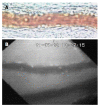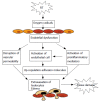Radiation-induced intestinal inflammation
- PMID: 17589918
- PMCID: PMC4172609
- DOI: 10.3748/wjg.v13.i22.3043
Radiation-induced intestinal inflammation
Abstract
Radiation induces an important inflammatory response in the irradiated organs, characterized by leukocyte infiltration and vascular changes that are the main limiting factor in the application of this therapeutic modality for the treatment of cancer. Recently, a considerable investigative effort has been directed at determining the molecular mechanisms by which radiation induces leukocyte recruitment, in order to create strategies to prevent intestinal inflammatory damage. In these review, we consider current available evidence on the factors governing the process of leukocyte recruitment in irradiated organs, mainly derived from experimental studies, with special attention to adhesion molecules, and their value as therapeutic targets.
Figures



Comment in
-
Tissue toxicity induced by ionizing radiation to the normal intestine: understanding the pathophysiological mechanisms to improve the medical management.World J Gastroenterol. 2007 Jun 14;13(22):3031-2. doi: 10.3748/wjg.v13.i22.3031. World J Gastroenterol. 2007. PMID: 17589916 Free PMC article. No abstract available.
References
-
- Ares C, Popowski Y, Mollà M, Rouzaud M, Nouet P, Escude Ll, Miralbell R. Hypofractionated Boost in prostate cancer radiotherapy as part of two different dose escalation strategies, HDR Brachytherapy or IMRT: A late rectal toxicity assessment. Int J Radiat Oncol Biol Phys. 2004;60:S477.
-
- Earnest DL, Trier JS. Sleisenger MH, Fordtran JS, editors. Gastrointestinal disease. Philadelphia: WB Saunders; 1989. Radiation enteritis and colitis; pp. 1369–1382.
-
- Rubin P, Johnston CJ, Williams JP, McDonald S, Finkelstein JN. A perpetual cascade of cytokines postirradiation leads to pulmonary fibrosis. Int J Radiat Oncol Biol Phys. 1995;33:99–109. - PubMed
-
- Panés J, Granger DN. Neutrophils generate oxygen free radicals in rat mesenteric microcirculation after abdominal irradiation. Gastroenterology. 1996;111:981–989. - PubMed
-
- Kimura H, Wu NZ, Dodge R, Spencer DP, Klitzman BM, McIntyre TM, Dewhirst MW. Inhibition of radiation-induced up-regulation of leukocyte adhesion to endothelial cells with the platelet-activating factor inhibitor, BN52021. Int J Radiat Oncol Biol Phys. 1995;33:627–633. - PubMed
Publication types
MeSH terms
LinkOut - more resources
Full Text Sources
Medical

